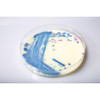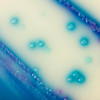Description
Intended Use
CHROMagar™ VRE is a selective and differential chromogenic medium, containing 6 mg/L of vancomycin. It is intended for use in the qualitative direct detection of vanA/vanB transmissible VRE-type gastrointestinal colonization with vancomycin-resistant Enterococcus faecium and Enterococcus faecalis (VRE) to aid in the prevention and control of VRE in healthcare settings. The test is performed with rectal swab and stools from patients to screen for VRE colonization. Results can be interpreted after 24 hours of aerobic incubation at 35-37 °C.
The medium can also be used as an early warning indicator for diagnostic tests of infections to signal the possible presence of multi drug-resistant bacteria. This use does not replace the institution’s protocols. CHROMagar™ VRE is not intended to diagnose VRE infection nor to guide nor monitor treatment for infections. A lack of growth or the absence of pink colonies on CHROMagar™ VRE does not preclude the presence of VRE. Further identification, susceptibility testing, and epidemiological typing is still required on suspect colonies.
It's a simple, fast and reliable tool for the direct detection of VRE strains with transmissible resistance : this is a precious help in the implementation of the appropriate control measures to prevent the spread of VRE.
In CHROMagar™ VRE, VRE. faecalis et VRE. faecium strains are easily distinguishable by the colony colour. In the contrary, in the classical agar for the detection of VRE (Bile Esculine Agar supplemented with vancomycin) :
(I) there is no differenciation between E. faecalis/ E. faecium ; (II) it often leads to false positives of other esculine hydrolising bacteria (like Lastococcus, Pediococcus...); (III) the black "cloud" makes plate reading difficult as well as the choice of the proper colony for further confirmatory tests.
CHROMagar™ VRE is supplied with a long shelf life (up to 18 months). This allows for flexibility of use, whether in an epidemic situation with many patients to screen, or whether for random surveillance of cultures.















